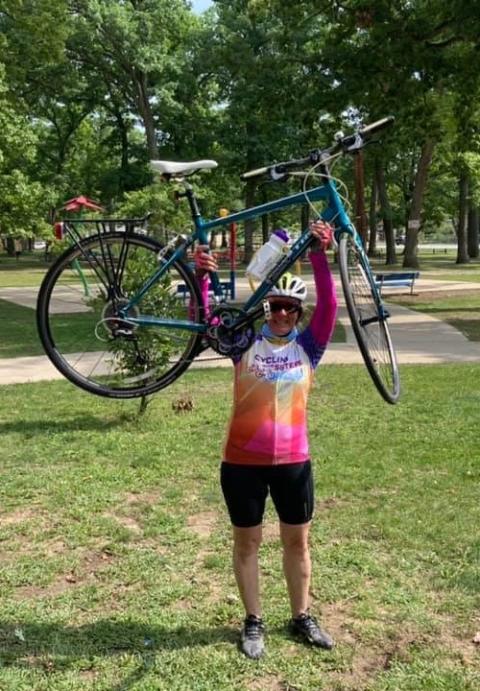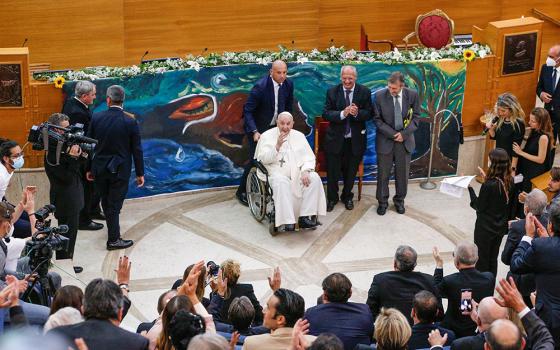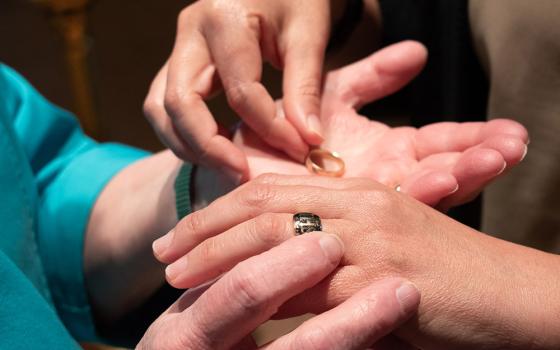The final five Cycling with Sisters riders arrive at their destination Sept. 11 in South Bend, Indiana, after a 60-mile ride from Chesterton to draw attention to the social justice work of Catholic women religious. (Nick Schafer)
We were somewhere around La Porte, halfway across Indiana, when we came to the hills.
On a bicycle, hills can quickly drain you of any drive you had to continue, wipe out your energy and make you question your life choices.
This county road would be 9 miles of hills, and we were not yet halfway into a 60-mile bike ride. This, I was certain, would be our crucible.
As a reporter, I am usually sworn to be an objective observer of the events I cover, never a participant. But the Cycling with Sisters 60-mile ride was to be an exception so I could write a firsthand account from the ride itself.
Cycling with Sisters was planned as a series of bike rides to draw attention to the social justice work of Catholic women religious, but because of the coronavirus pandemic, two of the four rides planned had to be canceled, one was rescheduled, and the South Bend ride, held Sept. 11, was dramatically changed to incorporate pandemic safety measures.
Cycling with Sisters has one more ride planned this year: a 15-mile ride Oct. 3 on Prince Edward Island, Canada. That ride, which will be compliant with COVID-19 safety guidelines, will have room for up to 40 riders.
Dan Stockman, Global Sisters Report's national correspondent, joined the Cycling with Sisters 60-mile ride Sept. 11 in Indiana to give a firsthand report. (Nick Schafer)
From a boy's 10-speed to a road bike
I put thousands of miles on my green Schwinn Varsity 10-speed as a teen, including a weekend ride at 14 with a youth group that covered 35 miles on Saturday to spend the night in a church basement and bike 35 miles back on Sunday. I finished the ride ready for 35 more.
Then I turned 15 and bought a moped. My bike was instantly forgotten.
Decades later, my wife, Krista, decided she needed a hobby that would keep her active. She joined the local bike club and began doing distance rides nearly every weekend until eventually, she began doing 100-mile rides.
In the last few years, she's wanted me to ride along, and I've done my best to keep up. I joined the bike club and did a few group rides, including a 40-mile ride that eclipsed even my teenage triumphs.
Then came COVID-19, and group rides were canceled, leaving the two of us to ride together. She patiently slowed down for me, and I did my best to keep up. When I saw that the Cycling with Sisters ride would be in the area, I reasoned it would be an easy way to combine work with pleasure and hit a new accomplishment on my bike, all at the same time.
Krista helped me train, going on longer and longer rides as the big day approached. But the weekend before the ride, when we planned to do 50 miles as final preparation, thunderstorms blanketed the area. Road bikes, which have tires devoid of tread and are so skinny their width is measured in millimeters, are incredibly dangerous on slippery surfaces. Our 43-mile ride the week before would have to suffice.
Finally, Sept. 10 arrived, and I made the two-hour drive to Chesterton, Indiana, where the ride would begin at dawn the next morning. I went to bed early but got no sleep, tossing and turning all night. I awoke full of adrenaline and ready to ride.
I rode around the parking lot to burn some adrenaline and warm up in the chilly air, and as I did, I noticed the handlebars were loose. My worst fears immediately ran through my head, and I assumed I had screwed something up badly the last time I made adjustments to my bike. I found Rob Layton, the owner of Bicycle Illinois, who was supporting our ride, and asked for an Allen wrench to tighten it back up.
He quickly discovered it wasn't the easily adjusted fitting on the stem that was loose; it was the bolt deep inside, which holds the entire front end together and requires a special tool to tighten. Had this happened out on the ride, my day might have been over. But Rob had the tool and tightened the bolt, and we were ready to go.
Advertisement
Prayers, pedaling and peanut butter
The best thing about long bike rides is they give your mind time to wander, something sorely lacking in our world. You can mull things over, ruminate and explore, all while seeing the landscape in a way that is impossible from a car.
The ride was planned as a "pedaling pilgrimage" to promote the social justice work of Catholic sisters and those who partner with them. At each stop, we would focus on a different issue, sharing the experience with those following along online. And through the whole ride, we would have a mantra: "Open wide my arms that the suffering of the world may come in."
Before the ride began, we focused on the 19th anniversary of the Sept. 11, 2001, terrorist attacks and the suffering caused by COVID-19 and prayed for hope and resilience. We prayed a prayer written by Benedictine Sr. Joan Chittister, which included the line: "Give us the courage to find you where you do not now appear to be."
And then we got on our bikes and began to ride.
As we pedaled through a countryside that was just waking up, I thought about that prayer and what it means to find God in places that seem to have been forsaken. I thought of the Lorica of St. Patrick, which talks about seeing Christ in the face of friends and strangers, and how different we become when we take even a moment to see Christ in the face of someone else.
This ride would be a pilgrimage, but our destination wasn't really a park in South Bend 60 miles away. It was to find Christ in all those who suffer. The hours of pedaling would be a physical reminder of the real, intense suffering of so many people today. There is no end in sight to their suffering, and it is much more than being saddle-sore or having tired legs.
The first stage passed without incident as we rode 13 miles to the first stop. Most of the first leg involved finding a comfortable and sustainable pace and getting to know the other eight riders, three of whom were sisters.

The prayers for social justice issues at each rest stop were livestreamed so viewers around the world could participate. (Nick Schafer)
It turns out our pace was much quicker than organizers planned, and we arrived at the first stop almost a half-hour early, which not only threw off the schedule for broadcasting to the online audience at that stop, but for the rest of the day.
But there was Gatorade and fruit and other snacks, and we were introduced to the glory that is the peanut butter gun: a caulk gun filled with peanut butter. I squeezed the handle to dollop that protein- and energy-rich wonder onto a banana, and it was perfect.
At that stop, we prayed for an end to human trafficking, and I was reminded how fortunate I am and how so many are not. If all of us saw the face of Christ in each other always, human trafficking and so many other woes could not exist.
When we got back on our bikes, with our mantra repeating through my mind, I prayed that any suffering I felt today would remind me of those who are truly suffering.
Ups and downs
It was only 8 miles to the next stop, and the tree-lined roads wound through the lakes of La Porte to a park, where we prayed for an end to racism and hate.
We had ridden 21 miles — one-third done already? — and everyone seemed to be holding up well. But the next rest stop was about 18 miles away, and almost half of it was the hills we had been warned about. After that: the final 20-mile push to the end.
While I had been praying that the suffering of the world would come into my arms, I suddenly feared I may not be able to take the suffering of this bike ride.
We headed out of La Porte and onto a long, country road that dipped and rolled through Indiana farmland.
Again, my mind wandered, contemplating the mysteries of our absurd obsession with race and how it seems to be woven into every fiber of our society. Will we ever get past this? And how will we do it? And why, even for self-professed Christians, is it so difficult for whites to see Christ in Black faces?
And then we hit the hills.

Daina Cyvas, communications and project coordinator for the Sisters of St. Casimir in Chicago, celebrates the end of the Cycling with Sisters ride on Sept. 11 in South Bend, Indiana. (Nick Schafer)
I was with a small group of riders at the front, and we would struggle up one side of a hill and then speed down the other, only to find another one in front of us. I quickly found I had to slow while going down the hill to avoid overtaking the other riders, losing the momentum I needed to get up the next one. I didn't want to ride out ahead of the group, but I knew that if I had to struggle up every hill, I would be in trouble.
So on the next hill, as we started down, instead of hitting the brakes, I swung out to the side and pedaled like a madman in one of my highest gears, gaining as much free momentum as I could. This put me far out ahead, but it also put me halfway up the next hill, and reaching the top was vastly easier. Perhaps I would survive, after all.
With each hill, I got a little further out from the group, which I felt bad about — until I heard a bike behind me. It was Sr. Sue Torgersen from the Congregation of St. Joseph, and she, too, needed the momentum of the drops to make it up the climbs. We tackled the hills together, flying down one hill and gliding much of the way up the next, hill after hill after hill.
When we turned off that hilly road, we realized we were only 2.5 miles from the rest stop. We had made it. We would survive. And just a few minutes after we rolled into the rest stop, the rest of the group did, too, and they looked as accomplished — and ready for more — as we did.
The glory of creation
At that final rest stop in a heavily wooded park, we prayed for the environment, and it was impossible not to be astounded by all the landscapes we had just ridden through and the forest we were resting and praying in.
On a bike, you are immersed in the country. You can smell the wildflowers on the side of the road. Cows and horses react to your presence. You feel the breeze that ripples the fields. The beauty of creation you can experience simply by slowing down is breathtaking.
Our last leg would be the final 20-mile push to the finish. We learned later that the route had been planned to go the other way so the rest stops would be closer together at the end. However, because of the pandemic, the ride went from a two-day trek from South Bend to Chicago to a one-day ride the other way, leaving from what had been the halfway point, Chesterton. And by then, it was too late to change all the stops because the picnic shelters had already been rented.
The final stage would be another test: We had a headwind straight into our faces, blowing at up to 12 mph. Headwinds, when you're on a bike, are just like hills; however, you can reach the top of a hill, but the wind never quits.
That became clear on a 4-mile stretch that went due east across wide-open fields, straight into the wind. Soon, two riders, both on their first long rides, dropped off the back of the group and disappeared. Sr. Maxine Kollasch of the Sisters, Servants of the Immaculate Heart of Mary, Clinton Franciscan Sr. Janet Ryan and I rode back to get them.
We found them about a mile back, stopped at a crossroads, afraid they had missed a turn and gone off the route. As the five of us began rolling, we showed them how to ride in a close group so the riders in front could block the wind, and soon, they were at the same speed as the rest of the group with much less effort. They realized that they, too, would make it.
We rode as a group the last 20 miles, going from farm fields to rolling woods to suburbs to inner city and, finally, to downtown South Bend. And then we were there, at the end.
As we rolled up, whooping and raising our fists, I looked down at my bike computer and saw the number: 60.0 miles. I had done the ride, but I hadn't accomplished my goal, which was to complete a metric century, or 100 kilometers. That distance is 62 miles, not 60.
So instead of turning in to the park, I kept going and found a few residential streets I could cruise until I hit that magic number of 62. Finally, after 5 hours and 18 minutes of riding, I could get off the bike.
Later, as we prayed for immigration reform, it was impossible not to think about our journey and what we had seen and learned along the way.
We were reminded that hundreds of thousands have journeyed on foot for thousands of miles, desperate for safety. We were doing our ride for many reasons, but none of us was doing it to save our lives or our children's lives. And none of us would be arrested and jailed at the end. Our children would not be put in cages. We weren't turned away, forced to live in refugee camps, waiting for months for the asylum hearings that U.S. and international law require.
Catholic sisters and all they accomplish continue to amaze me, and their social justice work is a model of how to solve the problems we prayed about that day.
I now have the accomplishment of completing a metric and the memories of a great ride with wonderful people. But I also have a new determination to see Christ in the face of friend and stranger and a new willingness to open wide my arms to the suffering of the world.
The nine Cycling with Sisters riders pose for a photo at the end of their 60-mile ride from Chesterton, Indiana, to South Bend on Sept. 11. (Nick Schafer)
[Dan Stockman is national correspondent for Global Sisters Report. His email address is dstockman@ncronline.org. Follow him on Twitter or on Facebook.]







